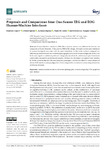Mostrar o rexistro simple do ítem
Proposals and Comparisons from One-Sensor EEG and EOG Human-Machine Interfaces
| dc.contributor.author | Laport López, Francisco | |
| dc.contributor.author | Iglesia, Daniel I. | |
| dc.contributor.author | Dapena, Adriana | |
| dc.contributor.author | Castro-Castro, Paula-María | |
| dc.contributor.author | Vázquez Araújo, Francisco Javier | |
| dc.date.accessioned | 2021-04-13T14:57:24Z | |
| dc.date.available | 2021-04-13T14:57:24Z | |
| dc.date.issued | 2021-03-22 | |
| dc.identifier.citation | Laport, F.; Iglesia, D.; Dapena, A.; Castro, P.M.; Vazquez-Araujo, F.J. Proposals and Comparisons from One-Sensor EEG and EOG Human-Machine Interfaces. Sensors 2021, 21, 2220. https://doi.org/10.3390/s21062220 | es_ES |
| dc.identifier.issn | 1424-8220 | |
| dc.identifier.uri | http://hdl.handle.net/2183/27737 | |
| dc.description.abstract | [Abstract] Human-Machine Interfaces (HMI) allow users to interact with different devices such as computers or home elements. A key part in HMI is the design of simple non-invasive interfaces to capture the signals associated with the user’s intentions. In this work, we have designed two different approaches based on Electroencephalography (EEG) and Electrooculography (EOG). For both cases, signal acquisition is performed using only one electrode, which makes placement more comfortable compared to multi-channel systems. We have also developed a Graphical User Interface (GUI) that presents objects to the user using two paradigms—one-by-one objects or rows-columns of objects. Both interfaces and paradigms have been compared for several users considering interactions with home elements. | es_ES |
| dc.description.sponsorship | Xunta de Galicia; ED431C 2020/15 | es_ES |
| dc.description.sponsorship | Xunta de Galicia; ED431G2019/01 | es_ES |
| dc.description.sponsorship | Agencia Estatal de Investigación de España; RED2018-102668-T | es_ES |
| dc.description.sponsorship | Agencia Estatal de Investigación de España; PID2019-104958RB-C42 | es_ES |
| dc.description.sponsorship | Xunta de Galicia; ED481A-2018/156 | es_ES |
| dc.description.sponsorship | This work has been funded by the Xunta de Galicia (by grant ED431C 2020/15, and grant ED431G2019/01 to support the Centro de Investigación de Galicia “CITIC”), the Agencia Estatal de Investigación of Spain (by grants RED2018-102668-T and PID2019-104958RB-C42) and ERDF funds of the EU (FEDER Galicia & AEI/FEDER, UE); and the predoctoral Grant No. ED481A-2018/156 (Francisco Laport) | |
| dc.language.iso | eng | es_ES |
| dc.publisher | MDPI AG | es_ES |
| dc.relation | info:eu-repo/grantAgreement/MICINN/Plan Estatal de Investigación Científica y Técnica y de Innovación 2017-2020/RED2018-102668-T/ES | |
| dc.relation | info:eu-repo/grantAgreement/AEI/Plan Estatal de Investigación Científica y Técnica y de Innovación 2017-2020/PID2019-104958RB-C42/ES/AVANCES EN CODIFICACION Y PROCESADO DE SEÑAL PARA LA SOCIEDAD DIGITAL | |
| dc.relation.uri | https://doi.org/10.3390/s21062220 | es_ES |
| dc.rights | Atribución 4.0 (CC BY) | es_ES |
| dc.rights.uri | https://creativecommons.org/licenses/by/4.0/ | * |
| dc.subject | Human-machine interfaces | es_ES |
| dc.subject | Electroencephalography | es_ES |
| dc.subject | Electrooculography | es_ES |
| dc.subject | P300 | es_ES |
| dc.subject | Graphical user interface | es_ES |
| dc.title | Proposals and Comparisons from One-Sensor EEG and EOG Human-Machine Interfaces | es_ES |
| dc.type | info:eu-repo/semantics/article | es_ES |
| dc.rights.access | info:eu-repo/semantics/openAccess | es_ES |
| UDC.journalTitle | Sensors | es_ES |
| UDC.volume | 21 | es_ES |
| UDC.issue | 6 | es_ES |
| UDC.startPage | 2220 | es_ES |
| dc.identifier.doi | 10.3390/s21062220 |
Ficheiros no ítem
Este ítem aparece na(s) seguinte(s) colección(s)
-
GI-GTEC - Artigos [193]






